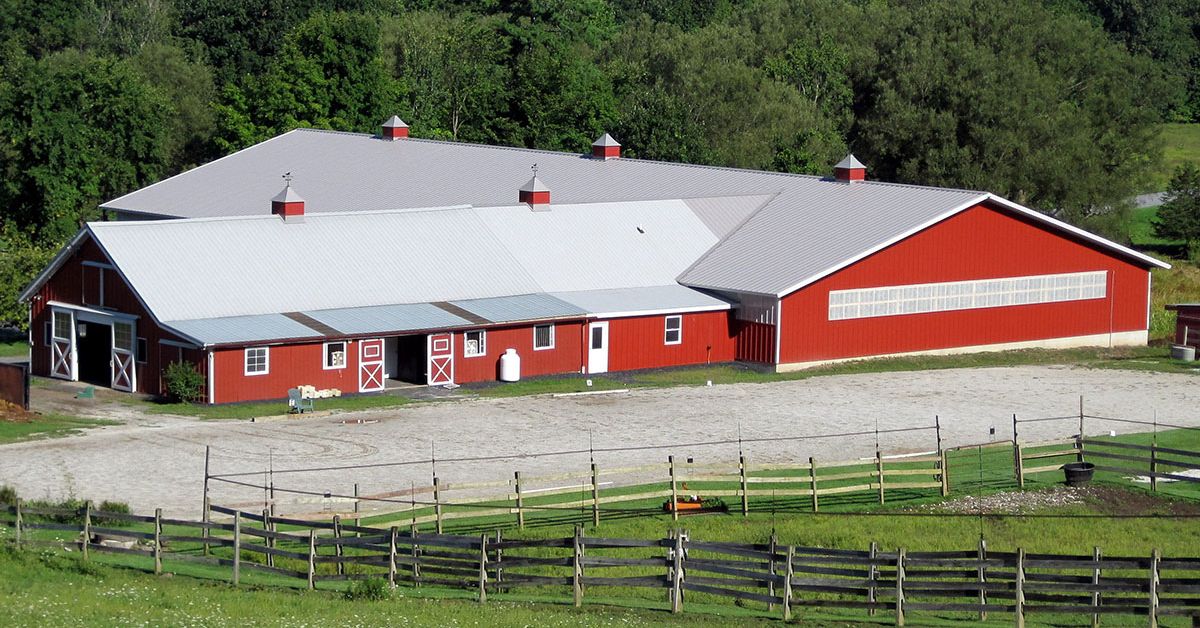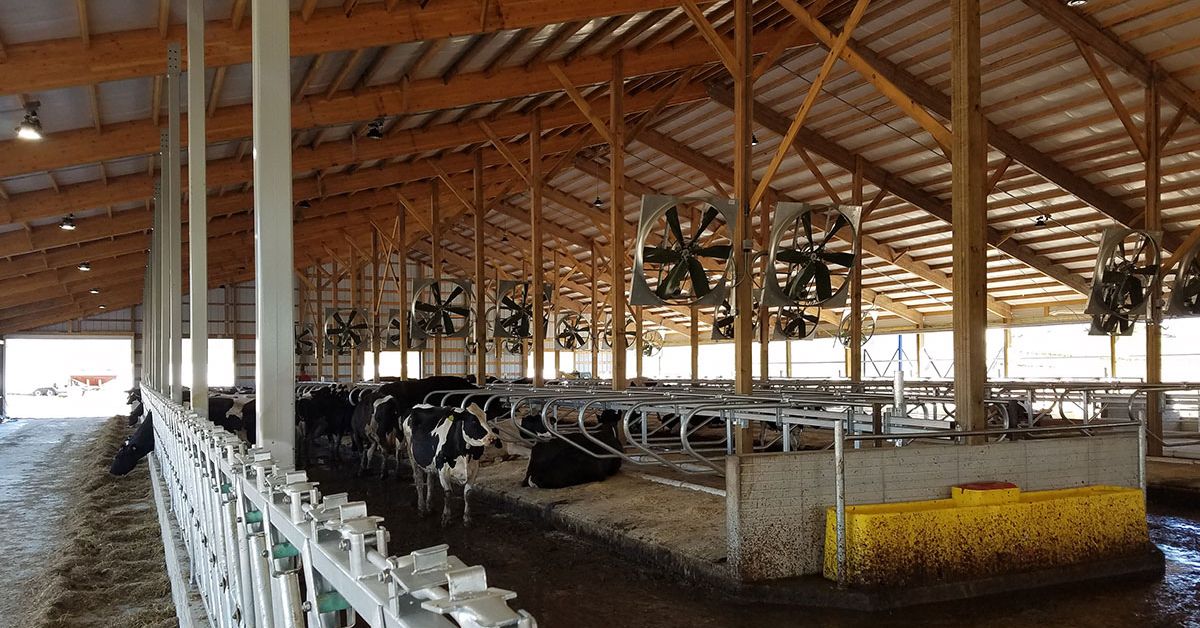How To Choose the Right Materials for a Livestock Barn
.jpg)
Choosing materials shapes the lifespan, safety, and daily performance of livestock barns. Animals stay healthier in structures that manage moisture, temperature, and airflow. Owners save money when materials last, repair easily, and perform predictably. This guide shares practical insights that help you evaluate options and build confidence as you plan. Our goal is simple: helping you choose the right materials for a livestock barn.
Factors To Consider When Selecting Barn Materials
There are a few factors that will determine which materials are most viable for your needs. Keep these aspects in mind as you review your options:
- Climate and weather conditions: Moisture, freeze–thaw cycles, wind, and UV exposure all influence how materials perform. Regions with heavy snow demand stronger roofs and frames. Coastal air can accelerate corrosion without proper coatings.
- Animal type and behavior: Dairy cows generate steady humidity and require hygienic, washable surfaces. Beef cattle bring impact loads and abrasion. Swine lead to corrosion that can challenge metal and fasteners. Horses need forgiving wall surfaces and quiet interiors.
- Budget constraints: Smart budgets weigh upfront cost against lifecycle expenses. Cheaper finishes can fail early when exposed to ammonia, manure acids, and repeated washdowns. Planned durability usually costs less across decades.
- Maintenance requirements: Some materials need routine sealing, painting, or power-washing. Others resist rot, pests, and corrosion with minimal attention. Labor availability and downtime tolerance should shape your choices.

Types of Materials for Livestock Barns
Wood
Wood delivers warmth, workability, and cost-effective framing. Pressure-treated lumber withstands ground contact, splash zones, and insect exposure. Hardwoods resist abrasion in high-traffic areas like alleys or bump zones. Routine inspection and strategic sealing defend against moisture and decay. Ventilation strategy matters because trapped humidity invites rot and mold.
Best uses include interior framing, non-contact wall sections, and decorative or horse-friendly finishes. Strategic placement away from heavy manure exposure extends service life. Proper fasteners and connectors reduce squeaks and movement under animal impact.
Steel
Steel frames and panels deliver strength, speed of construction, and excellent spanning ability. Galvanized steel resists corrosion in humid spaces, especially when paired with good airflow. Painted steel adds aesthetic appeal and UV resilience, with modern coatings offering strong durability. Unprotected steel can suffer in high-ammonia environments, particularly near manure storage and wash bays.
Best uses include primary structure, roof systems, and exterior cladding. Thoughtful detailing prevents condensation and thermal bridging. Girt and purlin design must align with wind and snow requirements in your region.
Concrete
Concrete floors and walls support hygiene, load, and durability. Poured concrete delivers seamless surfaces that clean quickly and shed water predictably. Concrete blocks offer modularity and robust impact resistance for kick zones and pen divisions. Finish selection also matters; broomed finishes aid traction, while polished or sealed surfaces clean more easily.
Acidic exposure from manure and silage can degrade unprotected concrete over time. Proper mix design, air entrainment in freeze zones, and approved sealers extend service life. Drainage design underpins animal comfort and labor efficiency.
Comparative Analysis of Materials
Cost: Initial Investment vs. Long-Term Expenses
Concrete and steel often require higher upfront spending, yet they pay back with durability and lower maintenance. Wood can be economical at installation, especially for framing and interior finishes. Replacement cycles and repair access should factor into your total cost view.
Durability and Lifespan
Steel and concrete take the lead in terms of structural longevity when designed and protected correctly. Wood performs well when kept dry and ventilated (and when treatments match exposure levels). Material interfaces often determine real durability, so flashing details and moisture management deserve attention.
Insulation and Ventilation
Healthy animals rely on steady air changes and managed condensation. Steel and wood systems offer great flexibility for insulated cavities, continuous ridge vents, and controlled sidewall inlets. Concrete stabilizes interior temperatures through thermal mass, which supports comfort in seasonal swings.
Ease of Installation and Repair
Installation and repair will be two factors worth really thinking about. You need to be able to work with the materials you pick, and they need to work with you.
Pre-engineered steel components can accelerate framing and reduce on-site guesswork. Wood remains highly adaptable for field adjustments and repairs with common tools. Concrete requires careful planning and skilled crews but rewards owners with cleanability and strength. Each material comes with unique advantages as well as unique needs; think about which option best suits you.
Practical Examples
Dairy: Steel Frame, Concrete Floors, Washable Liners
A midwestern dairy farm might select a galvanized steel frame with insulated wall panels and poured concrete throughout. Hygienic surfaces and controlled airflow cut mastitis risk and reduce bedding waste. Crews can pressure-wash alleys daily without damaging finishes. This setup allows for predictable maintenance.
Beef: Hybrid Wood-and-Steel With Block Pen Dividers
A cow–calf operation on the plains could benefit more from a steel roof system with wood interior framing and concrete block alleys. The blocks absorb impact from crowding and chute work. Wood allows for quick modifications as herd size shifts. Wide feed alleys keep equipment moving and downtime low.
Swine: Corrosion-Resistant Steel and Sealed Concrete
A farrow-to-finish site might use hot-dipped galvanized components, coated fasteners, and sealed concrete throughout. Ventilation and pit design keep ammonia moving out quickly. Corrosion slows dramatically with this setup, and fan housings last longer between replacements. Smart sealers and coatings can pay off within a few seasons.

Tips for Material Selection
- Consult with experts: Architects, engineers, and experienced builders can translate climate data, live loads, and animal behavior into smart specifications. Local agricultural experience matters.
- Research local building codes and regulations: Snow loads, fire ratings, setbacks, and nutrient management requirements drive key material choices. Early clarity prevents redesigns and delays.
- Obtain multiple quotes from suppliers: Comparable specs expose gaps in coatings, fastener grade, and warranty terms. Delivery timelines and crew availability influence total cost.
- Inspect materials before purchase: Grade stamps, treatment levels, coatings, and straightness affect performance. Verifying specs reduces surprises at installation.
Choosing With Confidence
Barns succeed when design and materials support animals, people, and operations every day. Builders and owners create value by balancing climate, species needs, budget, and maintenance. Materials never work in isolation; details, ventilation, and drainage turn good choices into great results. Seek guidance early and trust proven agricultural expertise. With that support, you can confidently choose the right materials for a livestock barn and build for decades of service.
Ready to map options to your site, herd, and goals? Design your livestock building with Lester Buildings. Our team will help you align structure, finishes, and budget. MyLester Design can bring your vision to life in an interactive 3D environment. Let’s start a plan that fits your animals and your operation, not the other way around.
